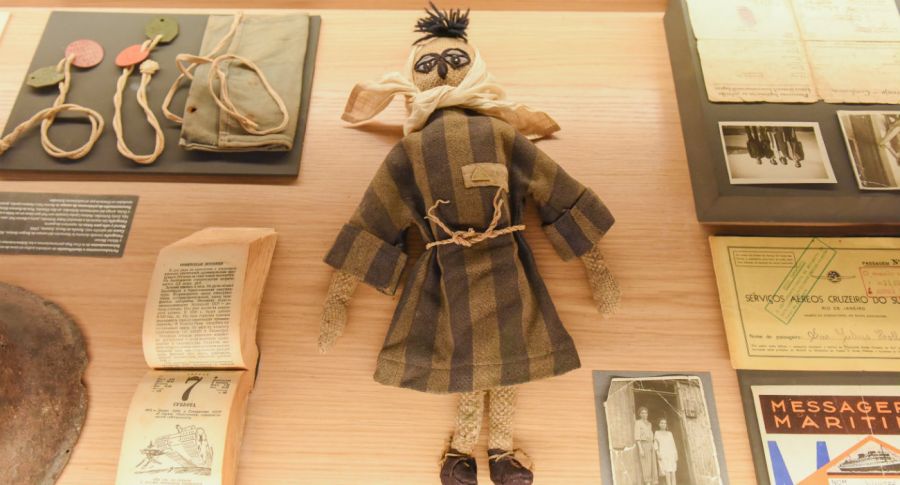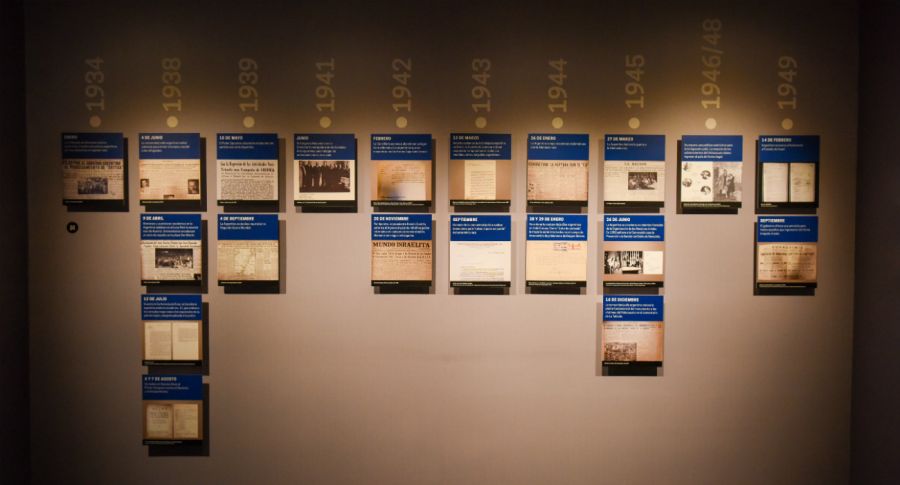Lea Zajac de Novera reclines comfortably into a grey armchair, her legs extended and crossed. Her elbows graze the seat’s armrests, and she flashes a faint, tender smile.
On her left forearm, slightly faded, the numbers 3-3-5-0-2 are etched onto the 93-year-old’s skin. They were tattooed onto her when she was a teenager, in Auschwitz.
Her gaze is heavy and focused, and her eyes meet mine — despite the fact that, technically, she’s not even there.
Humanity meets technology
The Holocaust Museum of Buenos Aires (Museo del Holocausto de Buenos Aires), located in Recoleta at Montevideo Street 919, will re-open to the public on Monday after a two-year refurbishment.
Costing US$4.5 million, its redevelopment has delivered a host of groundbreaking exhibits, most notably “Dimensions in Testimony,” a curated, interactive experience—already showing at select museums around the world—where visitors can virtually engage with survivors of the Shoah.
The first-ever “testimony” of this kind produced in Spanish is the testimony of Lea Zajac de Novera, which will soon be educating hundreds of thousands of visitors to the museum in the capital.
Projected onto a high-definition screen, Lea is adorned in a bright pink blouse, colourfully contrasted against the otherwise dark display.
Through a pixelated monitor, smart technology, and Lea’s compassionate humanity, visitors can engage with her directly — face to digital face.
“Where are you from?” I ask her.
A microphone, situated on top of a lectern across from Lea, translates the sound waves into data points that trigger Lea’s pre-recorded responses.
“I was born in Poland. December of 1926,” she responds.
The survivor’s entire story — as told by Lea herself — is there waiting for visitors, like an unopened history book.
On the very day Lea was set to begin secondary school, Germany invaded Poland. The Nazis quickly instituted restrictive laws that radically changed her day-to-day life.
Shortly thereafter, Lea and her family were confined into the ghetto of Pruzany, near Bialystok, where hunger and disease were rampant. After two years of living in squalour, Lea and her family were stocked into trains and shipped to the Auschwitz concentration camp.

Immediately upon arrival, her entire family was sent to the gas chambers. Lea, however, able-bodied and suitable for labour, was spared. She spent roughly two years there working, hiding, and suffering.
In January of 1945, as the Soviet Army advanced, the Nazis evacuated the camp and sent Lea on a death march, where many of her fellow prisoners, who had until that point survived the horror, either froze or starved to death.
Over the course of the Holocaust, 80 of the Polish teen’s relatives were murdered. But Lea — through grit, perseverance, and luck — survived the ghettos, Auschwitz, and the death marches.
She fled to Argentina in 1947, where she would eventually marry, have two children, and five grandchildren.

‘Tell the story’
The Fundación Memoria del Holocausto was first inaugurated in 1994. Five years later, the Argentine government granted the foundation 100 years of exclusive rights to a building in Recoleta that previously headquartered the Italo-Argentina Electric Company (Compañía Ítalo Argentina de Electricidad, CIAE).
The foundation converted the old powerplant into Argentina’s flagship Holocaust remembrance site, which would go on to serve the Buenos Aires community from 2000 to 2017, explained Jonathan Karszenbaum, the museum’s director.
For a city and a country whose Jewish legacy after the Holocaust is both rich and complicated, the foundation decided then that it was time to re-invest in the museum.
“The idea was to tell the story from Argentina’s point of view,” Karszenbaum told the Times.
After undergoing two years of renovations, the museum is set to re-open to the public on Monday. For the first week, from 1pm to 5pm, visitors can enter and tour the refurbished museum for free by signing up on the museum’s website beforehand.
“The creation of the new Holocaust museum in Buenos Aires was a debt — a debt we owed to society in general, and the Jewish society in particular,” said Mónica Dawidowicz, a survivor of the Shoah and a member of the museum’s commission of survivors.
“Argentina suffered two anti-Semitic attacks – first, the Israeli Embassy [bombing in 1992], and second, the building of the Jewish community of Argentina, AMIA [Argentine-Israeli Mutual Association], which still have not yet been resolved… it obliges us to double-down on our efforts in education,” she added.
The museum hopes that this modern, localised approach will serve future generations, keeping the memory of the Holocaust alive in Argentina.

“Memory is the only way to build the future and to prevent horror from happening again,” AMIA President Ariel Eichbaum told the Times. “In this sense, the Holocaust Museum of Buenos Aires is a clear benchmark and an example of what it means to commit to working to strengthen and keep alive the memory of what was the worst massacre of the 20th century.”
The museum’s refurbishment has been funded by private donors, businesses, and the City of Buenos Aires.
“It makes us proud that it’s in Buenos Aires,” said Enrique Avogadro, the City government’s Culture Minister, who praised the museum’s impactful message and “level of seriousness and modernity.”
Avogadro oversees the city’s opt-in patronage programme, which has a yearly budget of some 80 million pesos and allows private businesses to earmark a portion of their taxes for specific causes or non-profit institutions. The programme is involved in 1200 projects, Avogadro told the Times, and is a critical tool for the city in its support for cultural and educational initiatives.
In 2018, the City government contributed 10 million pesos to the museum’s renovation, and a year later, a further six million pesos.
The foundation’s track record and capacity to raise its own private funds makes the museum a “virtuous example” of the patronage programme, said Avogadro.
Testimonies
The museum, which is mostly laid out chronologically, features a vast digital archive of artifacts and testimonies — all from survivors who ended up in Argentina — available to visitors via user-friendly touch screens. Interactive maps, data-storytelling, and full-body sensory experiences are scattered throughout the space, ensuring visitors are fully immersed in the educational experience.
For example, as visitors approach the events of the 1930s, an overhead motion sensor triggers spine-chilling sounds of broken glass, leading the visitors into the museum’s exhibit about Kristallnacht.
“It is a modern museum, state of the art, equipped with applications that will serve to explain each of the phases,” explained Dawidowicz. “It will be a very important, fundamentally educational tool, visited by thousands of students each year.”
Walking through the section about life in concentration camps, visitors are directed to an indoor balcony with bleacher seating that overlooks a main room of the museum. The space is designed for pause and reflection, specifically where young students can gather as a group to debrief and talk about what they have witnessed, highlighting the museum’s holistic emphasis on the entire educational experience.
The museum concludes with a hopeful exhibit about the “Righteous Among the Nations,” non-Jews who risked their lives during the Holocaust to save individuals from extermination by the Nazis for altruistic reasons, and other individuals who committed acts of heroism during the Holocaust.
The final room of the exhibit contains a mirror — a symbol that reminds the departing visitor that it is up to them to stand up against injustice in the world.
Eichbaum, who represents much of the Jewish community in Argentina today, echoed the importance of this critical lesson: “The Holocaust Museum helps us not only to exercise our memory, but also to be alert to any seed of intolerance that gets planted.”

























Comments